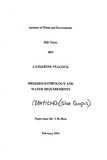JavaScript is disabled for your browser. Some features of this site may not work without it.
| dc.contributor.advisor | Hess, Tim M. | |
| dc.contributor.author | Peacock, Catherine | |
| dc.date.accessioned | 2009-10-19T11:57:19Z | |
| dc.date.available | 2009-10-19T11:57:19Z | |
| dc.date.issued | 2003-02 | |
| dc.identifier.uri | http://hdl.handle.net/1826/3836 | |
| dc.description.abstract | Stodmarsh National Nature Reserve includes the largest reedbed in Southern England and is an important habitat for breeding waders and several rare bird species, including Bitterns. A succession of drought years in the 1990s brought the issue of the hydrology and water requirements of the wetland to the attention of managers and there is concern about future water supplies to the reserve. This study aims to calculate the amount of water required by the site in order to maintain optimum habitat conditions. The greatest area of uncertainty in the water balance is the evapotranspiration rate of the reedbeds and therefore a secondary aim is to increase understanding of this flux. Detailed hydrological measurements were carried out over two years to establish the water balance of the site. Evapotranspiration was measured using the Bowen ratio technique, accompanied by additional physiological and meteorological measurements. Results showed that evapotranspiration from reeds was generally less than reference evapotranspiration and that stornatal resistance was the most important factor controlling evapotranspiration rates. The hydrology of the site was modelled using a thirty year historical data series to quantify the return periods of flood and drought conditions of different severity. These were used to predict water resource requirements and availability and confidence limits were attached to the results. In 70% of years, summer deficits in the rainfall-evapotranspiration balance require the addition of water from the Lampen Stream. In 10% of these years, the entire surmner discharge of the Lampen Stream would be insufficient to meet site water requirements and an additional source of water is required. Competition with other water users and limits on abstraction will increase the number of years an additional water source is required. In addition future climate change is likely to increase summer water requirements whilst decreasing resource availability. | en_UK |
| dc.language.iso | en | en_UK |
| dc.publisher | Cranfield University | en_UK |
| dc.title | Reedbed hydrology and water requirements | en_UK |
| dc.type | Thesis or dissertation | en_UK |
| dc.type.qualificationlevel | Doctoral | en_UK |
| dc.type.qualificationname | PhD | en_UK |
